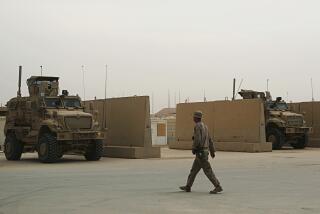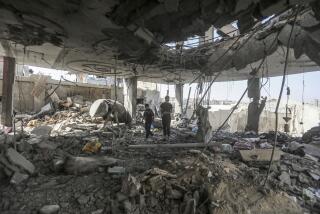CIA, U.S. military at odds over Afghanistan pullback plan
reporting from WASHINGTON — The CIA has made plans to close its network of secret bases in Afghanistan and pull its personnel back to Kabul this summer, an unexpectedly abrupt withdrawal that the U.S. military fears will deprive it of vital intelligence while thousands of American troops remain in the country, U.S. officials said.
CIA Director John Brennan informed U.S. military commanders in March that his agency would start to shutter Afghan operations outside Kabul, the capital, removing CIA clandestine officers and analysts as well as National Security Agency specialists responsible for intercepting insurgents’ communications, which have been a rich source of daily intelligence, the officials said.
Pentagon officials warn that the CIA drawdown is coming at a time when insurgent attacks normally intensify, after a winter lull. As a result, the plan has strained relations between the agency and military commanders in Kabul, the officials said.
“They are beginning their own retrograde and they kind of sprung it on the military, which is raising concern,” said a senior military official, who asked for anonymity because he was not authorized to discuss classified CIA plans.
Intelligence officials confirmed the drawdown would occur, but said the pace remained uncertain and no final plan had been approved.
They linked the move to the steady pullout of U.S. combat troops from America’s longest war. Soldiers and Marines have provided protection and logistics support for intelligence-gathering outposts, which often are inside U.S. military facilities. Hundreds of those frontline military bases and camps have now closed, although dozens are still operating.
“The CIA footprint is entirely dependent on the military’s,” a senior U.S. official said Thursday.
“There is no stomach in the building for going out there on our own,” said a former CIA operator who has spoken to current officers about the pullback. “We are not putting our people out there without U.S. forces.”
John Maguire, who retired from the CIA in 2005 after 23 years as a case officer, noted that CIA officers on horseback were the first U.S. forces into Afghanistan after the terrorist attacks of Sept. 11, 2001. He criticized the spy service for the current drawdown.
“There is ample evidence and a long historical record of the agency working alone in any number of difficult and dangerous places, and if they can’t do it by themselves without the military, then they should close the organization,” he said.
The CIA also plans this summer to stop paying the salaries of Afghan paramilitary forces that it has armed and trained for more than a decade to help fight the Taliban-led insurgency in the country’s east, near the Pakistani border. It is unclear what will happen to the militias.
The Pentagon is trying to persuade the CIA to slow its withdrawal, arguing that keeping CIA and NSA operators in the field as long as possible would help prevent a surge in militant attacks before the end of the year, when most U.S. troops are due to leave.
About 33,000 U.S. troops remain in Afghanistan, down from a peak of 100,000 in 2011.
U.S. Marine Corps Gen. Joseph F. Dunford Jr., the top commander in Afghanistan, has offered to help the CIA close its intelligence-gathering installations and remove its equipment late this year. By taking on that task, he hopes to persuade the CIA to remain in the field until at least October, one of the officials said.
Pentagon officials also are exploring whether the military can take over financial support of the CIA-backed militias to keep the Afghans from leaving the fight or switching sides, officials said. Some of the frontline units already have been disbanded, according to a report in the Daily Beast.
Brennan told military officials that the CIA would be able to continue gathering intelligence and targeting militants even after pulling back to Kabul and the nearby Bagram air base, one official said.
The spy service already has sharply cut the pace of lethal drone strikes in Pakistan, flown from airfields in Afghanistan. One official said the agency was making plans to continue operating the armed drones on a much smaller scale, from Bagram.
Several Al Qaeda commanders, including the terrorist network’s leader, Ayman Zawahiri, are believed to be hiding in northwestern Pakistan. The tribal belt also serves as a base for fighters from the Haqqani network, which is allied with the Taliban and has launched numerous attacks against U.S. and NATO forces in Afghanistan.
Brennan told the military that the CIA faced other priorities outside Afghanistan and Pakistan that were compelling it to redeploy staff, the official said.
The agency is increasingly focused on threats in Syria, Yemen and parts of Africa as Al Qaeda has morphed into regional affiliates that are seen as more dangerous to the U.S. and its allies.
The Sept. 11, 2012, attack on U.S. diplomatic and CIA compounds in Benghazi, Libya, highlighted the risk of operating with local security and a light footprint. The attack killed four Americans, including two ex-Navy SEALs working for the CIA.
The agency suffered one of its worst losses ever, however, when a suicide bomber got into a CIA base inside a heavily guarded U.S. military camp near Khowst, in eastern Afghanistan, on Dec. 30, 2009. The explosion killed seven American CIA officers and contractors, as well as a Jordanian intelligence officer and an Afghan working for the CIA.
The dispute has arisen as the Obama administration nears a decision on the size and mission of the force the U.S. hopes to keep in Afghanistan after this year.
Afghanistan’s outgoing president, Hamid Karzai, a harsh critic of U.S. policy in his country, has refused for months to sign a bilateral security agreement his government negotiated with Washington to allow a residual U.S. military force to remain beyond the end of 2014.
U.S. officials hope Karzai’s successor will sign the pact. An election was held in April, and the two leading contenders, former Foreign Minister Abdullah Abdullah and former World Bank executive Ashraf Ghani, will face a runoff in June.
The CIA’s abrupt withdrawal plan may be an indication of growing support within President Obama’s inner circle for a small U.S. footprint centered on Kabul and Bagram, to which the CIA would shift its drone operations.
Dunford is continuing to push for keeping more than 10,000 American troops to continue training and advising the Afghan military and police, as well as for counter-terrorism operations, officials said.
Military officials hope to persuade the CIA to keep a presence in southern and eastern Afghanistan after this year if the White House approves Dunford’s troop plan. It calls for deploying small numbers of advisors, trainers and special operations troops at a handful of locations outside Kabul.
Some White House aides are urging Obama to keep any U.S. force that remains focused on chasing the remnants of Al Qaeda and its supporters.
These officials favor abandoning plans to continue training and advising Afghan troops after 2014, arguing that little more can be accomplished, given that the mission is scheduled only for another year or two.
Caitlin Hayden, spokeswoman for the National Security Council, said Obama had not made a decision on how many U.S. troops to keep in Afghanistan, if they are allowed to stay. For now, she said, the administration was making contingency plans.
“When he does make those decisions, they will be focused on how we best accomplish our two core goals — combating the remnants of Al Qaeda and training and advising Afghan forces — and on the safety of our personnel,” she said.
Rep. Adam B. Schiff (D-Burbank), a member of the House Intelligence Committee, said the shrinking CIA operation in Afghanistan was inevitable as the military pulled back.
“It will mean that we have diminished insights into the Taliban and Al Qaeda operating there,” he said. “That does pose an additional risk to us. At the same time, it’s hard to justify increased troop numbers solely on the basis of intelligence support.”
More to Read
Sign up for Essential California
The most important California stories and recommendations in your inbox every morning.
You may occasionally receive promotional content from the Los Angeles Times.











